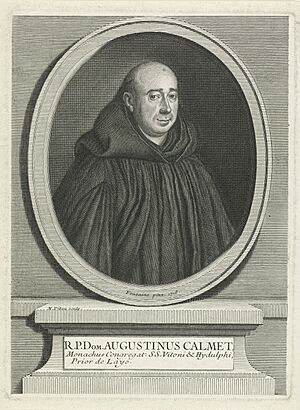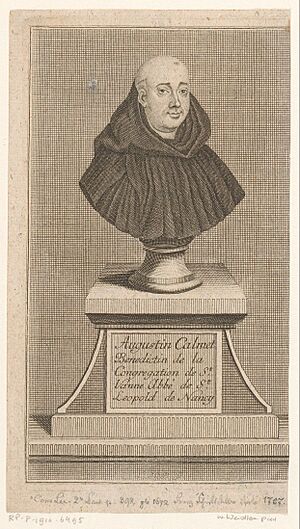Antoine Augustin Calmet facts for kids
Quick facts for kids The Rt. Rev. Father Abbot Dom Antoine Augustin Calmet, O.S.B. |
|
|---|---|
| Abbot of the Abbey of Senones | |

1750 engraving of Dom Augustin Calmet
|
|
| Other posts | Professor of Exegesis, Abbey of Moyenmoutier, and Abbot General of the Congregation of St. Vanne |
| Orders | |
| Ordination | 17 March 1696 |
| Personal details | |
| Born | 26 February 1672 Ménil-la-Horgne, Duchy of Bar, Holy Roman Empire |
| Died | 25 October 1757 (aged 85) Senones, County of Salm-Salm, Holy Roman Empire |
| Buried | Abbey of Senones |
| Profession | Abbot and exegete Historian; Scholar; Theologian; Philosopher, Occultist; Translator |
Antoine Augustin Calmet (born February 26, 1672 – died October 25, 1757) was a French Benedictine monk. He was born in Ménil-la-Horgne, which was then part of the Holy Roman Empire. Today, this area is in Meuse, France.
Calmet was a very smart and respected monk. He was known for his knowledge and became a leading member of the Congregation of St. Vanne, a group of Benedictine monasteries. Because of his skills, he was chosen for important roles. He became the prior of Lay-Saint-Christophe in 1715. Later, he became the Abbot of St-Léopold in Nancy in 1718, and then of Senones Abbey in 1729. He was even chosen twice to be the leader of his entire congregation. Pope Benedict XIII wanted to make him a Bishop, but Calmet humbly refused this high honor. He passed away at Senones Abbey in 1757.
Contents
About His Life
Augustin Calmet was born on February 26, 1672. His family was not wealthy; his father was a blacksmith. At age 15, he joined a Benedictine monastery called Breuil. He then studied at the University of Pont-à-Mousson. There, he learned about rhetoric, which is the art of speaking or writing effectively.
After his studies, he officially joined the Benedictine order. He took his monastic vows (special promises) on October 23, 1689. He continued his education, studying philosophy and theology (the study of religious faith).
He became a priest on March 1, 1696. After this, he was asked to teach about the holy scriptures (the Bible) at different abbeys. He also became a prior and later an abbot. Calmet traveled to many monasteries, reading and studying in their libraries. He wrote many historical books. In 1728, he became the abbot of Senones Saint-Pierre Abbey. He spent the rest of his life there, writing and exchanging letters with many scientists. He died on October 25, 1757.
How He Is Remembered
Today, there are squares named after him in Commercy and Senones. A street in Nancy is also called Dom-Calmet Street. In Metz, another street bears his name.
His monument is located in St. Peter's Abbey in Senones. It lists all the important books he wrote.
His Books
Bible Commentaries
Calmet started gathering information for his Bible commentary while teaching at the Abbey of Moyenmoutier. He finished this huge project at Munster in 1704. A commentary is a book that explains and interprets a text, in this case, the Bible.
His first volume, called Commentaire littéral sur tous les livres de l'Ancien et du Nouveau Testaments (A Literal Commentary on all the Books of the Old and New Testaments), came out in Paris in 1707. The last of his twenty-three volumes was published in 1716. This work was very popular, so new editions were printed. It was even translated into Latin and other languages. This shows how highly people thought of his work.
Calmet's commentary was special because it focused on the literal meaning of the Bible. Before him, many commentaries also included mystical or moral interpretations. He also added helpful introductions to each book of the Bible. He wrote 114 detailed essays on specific topics. These essays were so popular that he published them separately. They were translated into English and other languages.
Studies on Spirits and Vampires
In 1746, Calmet wrote a book with a long title: Dissertations sur les apparitions des anges, des démons et des esprits, et sur les revenants et vampires de Hongrie, de Bohême, de Moravie et de Silésie. This translates to "Dissertations on the Apparitions of Angels, Demons, and Spirits, and on the Revenants and Vampires of Hungary, Bohemia, Moravia, and Silesia."
In this book, he carefully studied stories about angels, demons, and other spirits. He also looked into topics like magic, witchcraft, and accounts of vampires and people returning from the grave. He analyzed these stories from the Bible, old myths, cultural legends, and historical claims from places like Hungary. He approached these topics in a scholarly way, trying to understand the stories rather than just believing them.
The famous writer Voltaire even mentioned Calmet's work. Voltaire was surprised that such a serious scholar in the 18th century would write about vampires. Calmet received many letters about his first book. This led him to expand his work into two volumes, published in 1751. In this new edition, he included more of his own studies and letters he received. He considered the possibility of vampires existing, but he did not state it as a fact.
Other Important Works
Calmet also wrote other books related to the Bible. One was Histoire de l'Ancien et du Nouveau Testament et des Juifs (History of the Old and New Testaments and of the Jews), published in 1718. This book was also translated into English and German.
Another major work was his Dictionnaire historique, critique, chronologique, géographique et littéral de la Bible (Historical, Critical, Chronological, Geographical, and Literal Dictionary of the Bible). This dictionary was published in 1720 and was later improved and reprinted many times. It was also translated into Latin and other European languages.
Among his other published works are:
- Histoire universelle sacrée et profane (Universal History, Sacred and Profane) from 1735. This book covered history from the beginning of the world.
- Histoire ecclésiastique et civile de la Lorraine (Ecclesiastical and Civil History of Lorraine) from 1728. This book is very important for understanding the history of the Lorraine region in France.
- Bibliothèque lorraine (A Catalogue of the Writers of Lorraine) from 1751. This book included his own life story.
- Commentaire littéral historique et moral sur la règle de Saint Benoît (A Literal, Moral, and Historical Commentary on the Rule of Saint Benedict) from 1734. This book explained the rules for Benedictine monks.
Calmet also wrote a history of the Duchy of Lorraine and a history of the Abbey of Senones. These were still in manuscript form when he died.


